使用 Ktor 和 SQLDelight 建立多平台應用程式
本教學使用 IntelliJ IDEA,但您也可以在 Android Studio 中遵循此教學 – 這兩個 IDE 都共享相同的核心功能和 Kotlin 多平台支援。
本教學示範如何使用 IntelliJ IDEA 建立一個進階的 iOS 和 Android 行動應用程式,並使用 Kotlin 多平台。 此應用程式將:
- 使用 Ktor 從公共 SpaceX API 透過網際網路擷取資料。
- 使用 SQLDelight 將資料儲存到本地資料庫。
- 顯示 SpaceX 火箭發射列表,包括發射日期、結果以及詳細的發射描述。
此應用程式將包含一個模組,其中包含適用於 iOS 和 Android 平台的共享程式碼。業務邏輯和資料存取層將在共享模組中僅實作一次,而這兩個應用程式的 UI 都將是原生的。
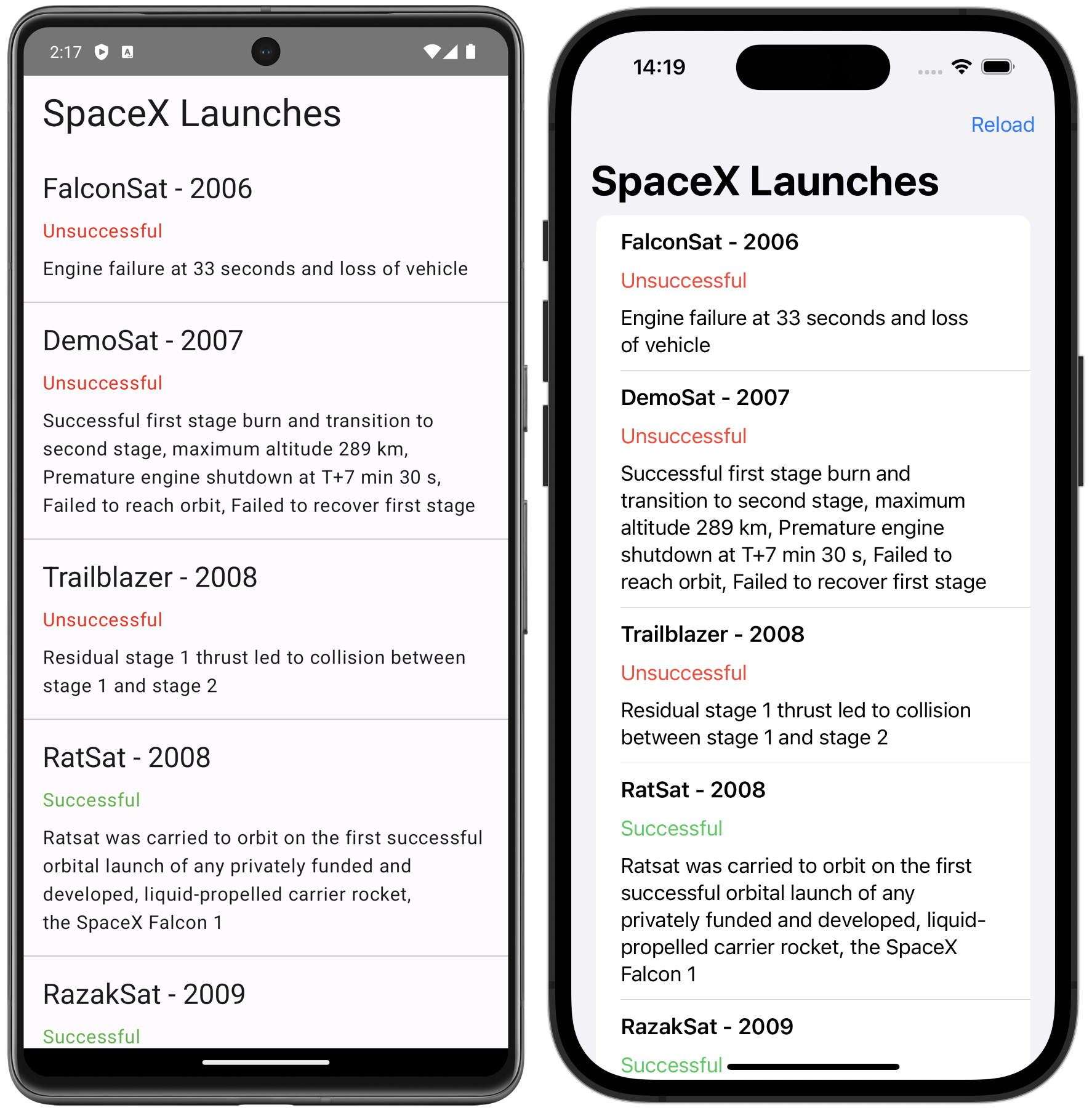
您將在專案中使用以下多平台函式庫:
- Ktor 作為 HTTP 客戶端,用於透過網際網路擷取資料。
kotlinx.serialization用於將 JSON 回應反序列化為實體類別的物件。kotlinx.coroutines用於編寫非同步程式碼。- SQLDelight 用於從 SQL 查詢生成 Kotlin 程式碼並建立型別安全資料庫 API。
- Koin 透過依賴注入提供平台專用資料庫驅動程式。
建立專案
在 快速入門 中,完成設定 Kotlin 多平台開發環境的說明。
在 IntelliJ IDEA 中,選取 File | New | Project。
在左側面板中,選取 Kotlin Multiplatform (在 Android Studio 中,該範本可以在 New Project 精靈的 Generic 分頁中找到)。
在 New Project 視窗中指定以下欄位:
- Name: SpaceTutorial
- Group: com.jetbrains
- Artifact: spacetutorial
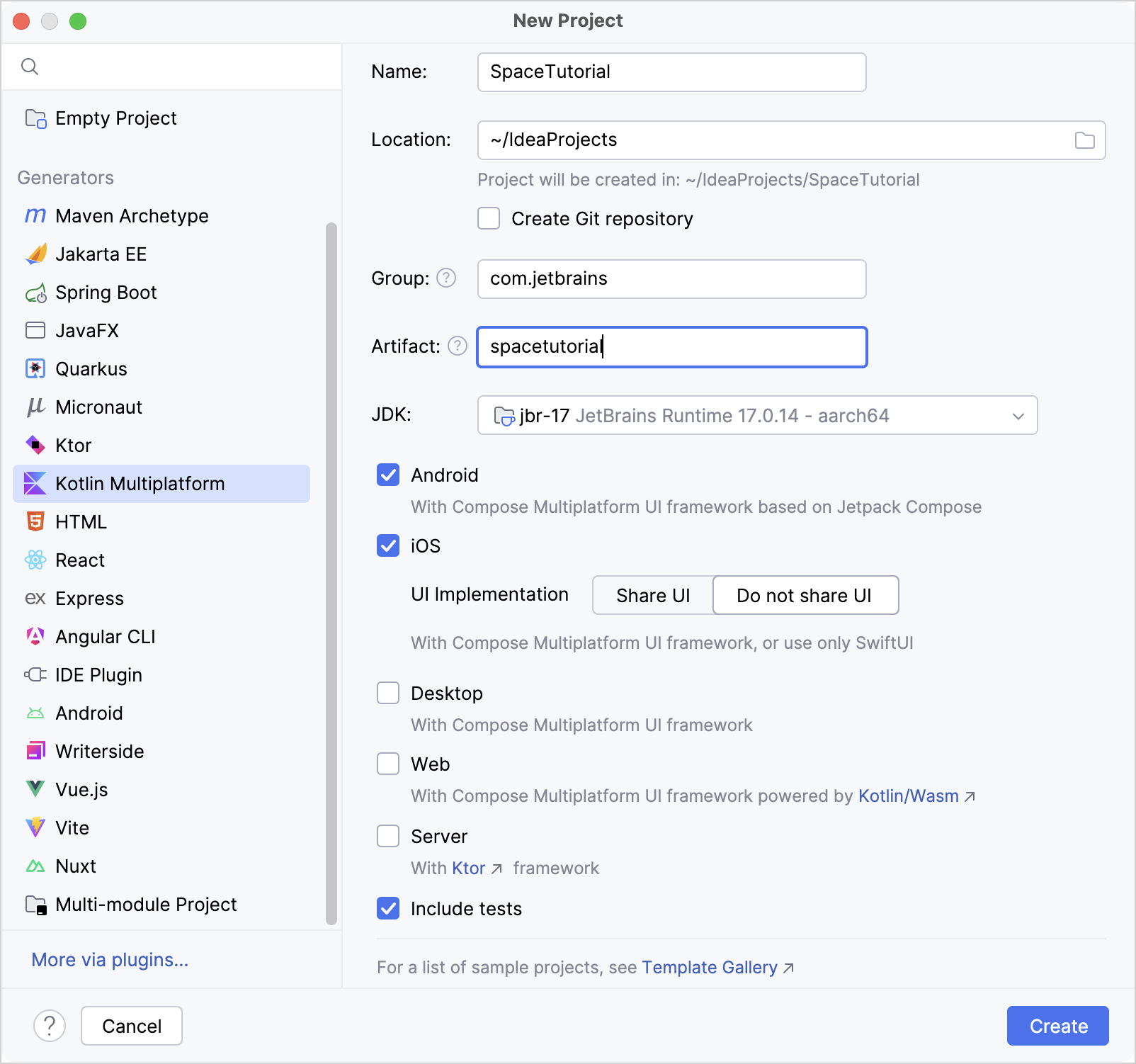
選取 Android 和 iOS 目標。
對於 iOS,選取 Do not share UI 選項。您將為這兩個平台實作原生 UI。
指定所有欄位和目標後,按一下 Create。
新增 Gradle 依賴項
要將多平台函式庫新增到共享模組中,您需要將依賴項指令 (implementation) 新增到 build.gradle.kts 檔案中相關原始碼集的 dependencies {} 區塊中。
kotlinx.serialization 和 SQLDelight 函式庫還需要額外的配置。
在 gradle/libs.versions.toml 檔案的版本目錄中更改或新增行以反映所有必需的依賴項:
在
[versions]區塊中,檢查 AGP 版本並新增其餘部分:[versions] agp = "8.7.3" ... coroutinesVersion = "1.10.2" dateTimeVersion = "0.7.1" koin = "4.1.0" ktor = "3.3.1" sqlDelight = "2.1.0" material3 = "1.3.2"在
[libraries]區塊中,新增以下函式庫參考:[libraries] ... android-driver = { module = "app.cash.sqldelight:android-driver", version.ref = "sqlDelight" } koin-androidx-compose = { module = "io.insert-koin:koin-androidx-compose", version.ref = "koin" } koin-core = { module = "io.insert-koin:koin-core", version.ref = "koin" } kotlinx-coroutines-core = { module = "org.jetbrains.kotlinx:kotlinx-coroutines-core", version.ref = "coroutinesVersion" } kotlinx-datetime = { module = "org.jetbrains.kotlinx:kotlinx-datetime", version.ref = "dateTimeVersion" } ktor-client-android = { module = "io.ktor:ktor-client-android", version.ref = "ktor" } ktor-client-content-negotiation = { module = "io.ktor:ktor-client-content-negotiation", version.ref = "ktor" } ktor-client-core = { module = "io.ktor:ktor-client-core", version.ref = "ktor" } ktor-client-darwin = { module = "io.ktor:ktor-client-darwin", version.ref = "ktor" } ktor-serialization-kotlinx-json = { module = "io.ktor:ktor-serialization-kotlinx-json", version.ref = "ktor" } native-driver = { module = "app.cash.sqldelight:native-driver", version.ref = "sqlDelight" } runtime = { module = "app.cash.sqldelight:runtime", version.ref = "sqlDelight" } androidx-compose-material3 = { module = "androidx.compose.material3:material3", version.ref="material3" }在
[plugins]區塊中,指定必要的 Gradle 外掛程式:[plugins] ... kotlinxSerialization = { id = "org.jetbrains.kotlin.plugin.serialization", version.ref = "kotlin" } sqldelight = { id = "app.cash.sqldelight", version.ref = "sqlDelight" }新增依賴項後,系統會提示您重新同步專案。按一下 Sync Gradle Changes 按鈕以同步 Gradle 檔案:

在
shared/build.gradle.kts檔案的最開頭,將以下行新增到plugins {}區塊中:kotlinplugins { // ... alias(libs.plugins.kotlinxSerialization) alias(libs.plugins.sqldelight) }通用原始碼集需要每個函式庫的核心構件,以及 Ktor 序列化功能 以使用
kotlinx.serialization處理網路請求和回應。iOS 和 Android 原始碼集也需要 SQLDelight 和 Ktor 平台驅動程式。在相同的
shared/build.gradle.kts檔案中,新增所有必需的依賴項:kotlinkotlin { // ... sourceSets { commonMain.dependencies { implementation(libs.kotlinx.coroutines.core) implementation(libs.ktor.client.core) implementation(libs.ktor.client.content.negotiation) implementation(libs.ktor.serialization.kotlinx.json) implementation(libs.runtime) implementation(libs.kotlinx.datetime) implementation(libs.koin.core) } androidMain.dependencies { implementation(libs.ktor.client.android) implementation(libs.android.driver) } iosMain.dependencies { implementation(libs.ktor.client.darwin) implementation(libs.native.driver) } } }在
sourceSets區塊的開頭,選擇啟用標準 Kotlin 函式庫的實驗性時間 API:kotlinkotlin { // ... sourceSets { all { languageSettings.optIn("kotlin.time.ExperimentalTime") } // ... } }新增依賴項後,再次按一下 Sync Gradle Changes 按鈕以同步 Gradle 檔案。
Gradle 同步後,您就完成了專案配置,可以開始編寫程式碼了。
有關多平台依賴項的深入指南,請參閱 對 Kotlin 多平台函式庫的依賴項。
建立應用程式資料模型
本教學應用程式將包含公開的 SpaceXSDK 類別,作為網路和快取服務的外觀。 應用程式資料模型將有三個實體類別:
- 關於發射的一般資訊
- 任務徽章圖片的連結
- 與發射相關文章的 URL
在本教學結束時,並非所有這些資料都會呈現在 UI 中。 我們使用資料模型來展示序列化。 但您可以試著使用連結和徽章來擴展此範例,使其包含更多資訊!
建立必要的資料類別:
在
shared/src/commonMain/kotlin/com/jetbrains/spacetutorial目錄中,建立entity套件,然後在該套件中建立Entity.kt檔案。宣告基本實體的所有資料類別:
kotlin
每個可序列化類別都必須標記有 @Serializable 註解。kotlinx.serialization 外掛程式會自動為 @Serializable 類別生成預設序列化器,除非您在註解引數中明確傳遞序列化器的連結。
@SerialName 註解允許您重新定義欄位名稱,這有助於使用更具可讀性的識別符號存取資料類別中的屬性。
配置 SQLDelight 並實作快取邏輯
配置 SQLDelight
SQLDelight 函式庫允許您從 SQL 查詢生成型別安全的 Kotlin 資料庫 API。在編譯期間,生成器會驗證 SQL 查詢並將其轉換為可在共享模組中使用的 Kotlin 程式碼。
SQLDelight 依賴項已包含在專案中。要配置函式庫,請開啟 shared/build.gradle.kts 檔案並在末尾新增 sqldelight {} 區塊。此區塊包含資料庫及其參數的列表:
sqldelight {
databases {
create("AppDatabase") {
packageName.set("com.jetbrains.spacetutorial.cache")
}
}
}packageName 參數指定生成 Kotlin 原始碼的套件名稱。
當系統提示時同步 Gradle 專案檔案,或按兩下 並搜尋 Sync All Gradle, Swift Package Manager projects。
考慮安裝官方 SQLDelight 外掛程式 以使用
.sq檔案。
生成資料庫 API
首先,使用所有必需的 SQL 查詢建立 .sq 檔案。依預設,SQLDelight 外掛程式會在原始碼集的 sqldelight 資料夾中尋找 .sq 檔案:
在
shared/src/commonMain目錄中,建立一個新的sqldelight目錄。在
sqldelight目錄內,建立一個名為com/jetbrains/spacetutorial/cache的新目錄,以建立套件的巢狀目錄。在
cache目錄內,建立AppDatabase.sq檔案(名稱與您在build.gradle.kts檔案中指定的資料庫名稱相同)。 您的應用程式的所有 SQL 查詢都將儲存在此檔案中。資料庫將包含一個包含發射資料的表。 將以下建立表的程式碼新增到
AppDatabase.sq檔案中:textimport kotlin.Boolean; CREATE TABLE Launch ( flightNumber INTEGER NOT NULL, missionName TEXT NOT NULL, details TEXT, launchSuccess INTEGER AS Boolean DEFAULT NULL, launchDateUTC TEXT NOT NULL, patchUrlSmall TEXT, patchUrlLarge TEXT, articleUrl TEXT );新增
insertLaunch函數以將資料插入表中:textinsertLaunch: INSERT INTO Launch(flightNumber, missionName, details, launchSuccess, launchDateUTC, patchUrlSmall, patchUrlLarge, articleUrl) VALUES(?, ?, ?, ?, ?, ?, ?, ?);新增
removeAllLaunches函數以清除表中的資料:textremoveAllLaunches: DELETE FROM Launch;宣告
selectAllLaunchesInfo函數以擷取資料:textselectAllLaunchesInfo: SELECT Launch.* FROM Launch;生成對應的
AppDatabase介面(稍後您將使用資料庫驅動程式初始化它)。 為此,在終端機中執行以下命令:shell./gradlew generateCommonMainAppDatabaseInterface生成的 Kotlin 程式碼儲存在
shared/build/generated/sqldelight目錄中。
建立平台專用資料庫驅動程式的工廠
要初始化 AppDatabase 介面,您將向其傳遞一個 SqlDriver 實例。 SQLDelight 提供了 SQLite 驅動程式的多種平台專用實作,因此您需要為每個平台單獨建立這些實例。
雖然您可以透過預期和實際介面實現此目的,但在本專案中,您將使用 Koin 來嘗試 Kotlin 多平台中的依賴注入。
為資料庫驅動程式建立一個介面。為此,在
shared/src/commonMain/kotlin/com/jetbrains/spacetutorial/目錄中,建立cache套件。在
cache套件中建立DatabaseDriverFactory介面:kotlinpackage com.jetbrains.spacetutorial.cache import app.cash.sqldelight.db.SqlDriver interface DatabaseDriverFactory { fun createDriver(): SqlDriver }為 Android 建立實作此介面的類別:在
shared/src/androidMain/kotlin目錄中,建立com.jetbrains.spacetutorial.cache套件,然後在其中建立DatabaseDriverFactory.kt檔案。在 Android 上,SQLite 驅動程式由
AndroidSqliteDriver類別實作。在DatabaseDriverFactory.kt檔案中,將資料庫資訊和 context 連結傳遞給AndroidSqliteDriver類別建構函數:kotlinpackage com.jetbrains.spacetutorial.cache import android.content.Context import app.cash.sqldelight.db.SqlDriver import app.cash.sqldelight.driver.android.AndroidSqliteDriver class AndroidDatabaseDriverFactory(private val context: Context) : DatabaseDriverFactory { override fun createDriver(): SqlDriver { return AndroidSqliteDriver(AppDatabase.Schema, context, "launch.db") } }對於 iOS,在
shared/src/iosMain/kotlin/com/jetbrains/spacetutorial/目錄中,建立cache套件。在
cache套件中,建立DatabaseDriverFactory.kt檔案並新增此程式碼:kotlinpackage com.jetbrains.spacetutorial.cache import app.cash.sqldelight.db.SqlDriver import app.cash.sqldelight.driver.native.NativeSqliteDriver class IOSDatabaseDriverFactory : DatabaseDriverFactory { override fun createDriver(): SqlDriver { return NativeSqliteDriver(AppDatabase.Schema, "launch.db") } }
您稍後將在專案的平台專用程式碼中實作這些驅動程式的實例。
實作快取
到目前為止,您已新增平台資料庫驅動程式的工廠和一個 AppDatabase 介面以執行資料庫操作。現在,建立一個 Database 類別,它將包裝 AppDatabase 介面並包含快取邏輯。
在通用原始碼集
shared/src/commonMain/kotlin中,在com.jetbrains.spacetutorial.cache套件中建立一個新的Database類別。它將包含兩個平台通用的邏輯。要為
AppDatabase提供驅動程式,請將抽象的DatabaseDriverFactory實例傳遞給Database類別建構函數:kotlinpackage com.jetbrains.spacetutorial.cache internal class Database(databaseDriverFactory: DatabaseDriverFactory) { private val database = AppDatabase(databaseDriverFactory.createDriver()) private val dbQuery = database.appDatabaseQueries }此類別的可見性設定為 internal,這表示它只能從多平台模組內部存取。
在
Database類別中,實作一些資料處理操作。 首先,建立getAllLaunches函數以傳回所有火箭發射的列表。mapLaunchSelecting函數用於將資料庫查詢結果映射到RocketLaunch物件:kotlinimport com.jetbrains.spacetutorial.entity.Links import com.jetbrains.spacetutorial.entity.Patch import com.jetbrains.spacetutorial.entity.RocketLaunch internal class Database(databaseDriverFactory: DatabaseDriverFactory) { // ... internal fun getAllLaunches(): List<RocketLaunch> { return dbQuery.selectAllLaunchesInfo(::mapLaunchSelecting).executeAsList() } private fun mapLaunchSelecting( flightNumber: Long, missionName: String, details: String?, launchSuccess: Boolean?, launchDateUTC: String, patchUrlSmall: String?, patchUrlLarge: String?, articleUrl: String? ): RocketLaunch { return RocketLaunch( flightNumber = flightNumber.toInt(), missionName = missionName, details = details, launchDateUTC = launchDateUTC, launchSuccess = launchSuccess, links = Links( patch = Patch( small = patchUrlSmall, large = patchUrlLarge ), article = articleUrl ) ) } }新增
clearAndCreateLaunches函數以清除資料庫並插入新資料:kotlininternal class Database(databaseDriverFactory: DatabaseDriverFactory) { // ... internal fun clearAndCreateLaunches(launches: List<RocketLaunch>) { dbQuery.transaction { dbQuery.removeAllLaunches() launches.forEach { launch -> dbQuery.insertLaunch( flightNumber = launch.flightNumber.toLong(), missionName = launch.missionName, details = launch.details, launchSuccess = launch.launchSuccess ?: false, launchDateUTC = launch.launchDateUTC, patchUrlSmall = launch.links.patch?.small, patchUrlLarge = launch.links.patch?.large, articleUrl = launch.links.article ) } } } }
實作 API 服務
要透過網際網路擷取資料,您將使用 SpaceX 公共 API 和一個單一方法從 v5/launches 端點擷取所有發射的列表。
建立一個將應用程式連接到 API 的類別:
在
shared/src/commonMain/kotlin/com/jetbrains/spacetutorial/目錄中,建立一個network套件。在
network目錄中,建立SpaceXApi類別:kotlinpackage com.jetbrains.spacetutorial.network import io.ktor.client.HttpClient import io.ktor.client.plugins.contentnegotiation.ContentNegotiation import io.ktor.serialization.kotlinx.json.json import kotlinx.serialization.json.Json class SpaceXApi { private val httpClient = HttpClient { install(ContentNegotiation) { json(Json { ignoreUnknownKeys = true useAlternativeNames = false }) } } }此類別執行網路請求並將 JSON 回應反序列化為
com.jetbrains.spacetutorial.entity套件中的實體。 KtorHttpClient實例初始化並儲存httpClient屬性。此程式碼使用 Ktor
ContentNegotiation外掛程式 以反序列化GET請求的結果。此外掛程式處理請求和回應酬載為 JSON,並根據需要進行序列化和反序列化。宣告傳回火箭發射列表的資料擷取函數:
kotlinimport com.jetbrains.spacetutorial.entity.RocketLaunch import io.ktor.client.request.get import io.ktor.client.call.body class SpaceXApi { // ... suspend fun getAllLaunches(): List<RocketLaunch> { return httpClient.get("https://api.spacexdata.com/v5/launches").body() } }
getAllLaunches 函數具有 suspend 修飾符,因為它包含對暫停函數 HttpClient.get() 的呼叫。 get() 函數包含一個透過網際網路擷取資料的非同步操作,只能從協程或另一個暫停函數中呼叫。網路請求將在 HTTP 客戶端的執行緒池中執行。
用於發送 GET 請求的 URL 作為引數傳遞給 get() 函數。
建立 SDK
您的 iOS 和 Android 應用程式將透過共享模組與 SpaceX API 進行通訊,該模組將提供一個公開類別 SpaceXSDK。
在通用原始碼集
shared/src/commonMain/kotlin中,在com.jetbrains.spacetutorial套件中建立SpaceXSDK類別。 此類別將是Database和SpaceXApi類別的外觀。要建立
Database類別實例,請提供一個DatabaseDriverFactory實例:kotlinpackage com.jetbrains.spacetutorial import com.jetbrains.spacetutorial.cache.Database import com.jetbrains.spacetutorial.cache.DatabaseDriverFactory import com.jetbrains.spacetutorial.network.SpaceXApi class SpaceXSDK(databaseDriverFactory: DatabaseDriverFactory, val api: SpaceXApi) { private val database = Database(databaseDriverFactory) }您將透過
SpaceXSDK類別建構函數在平台專用程式碼中注入正確的資料庫驅動程式。新增
getLaunches函數,它使用建立的資料庫和 API 來獲取發射列表:kotlinimport com.jetbrains.spacetutorial.entity.RocketLaunch class SpaceXSDK(databaseDriverFactory: DatabaseDriverFactory, val api: SpaceXApi) { // ... @Throws(Exception::class) suspend fun getLaunches(forceReload: Boolean): List<RocketLaunch> { val cachedLaunches = database.getAllLaunches() return if (cachedLaunches.isNotEmpty() && !forceReload) { cachedLaunches } else { api.getAllLaunches().also { database.clearAndCreateLaunches(it) } } } }
該類別包含一個用於獲取所有發射資訊的函數。根據 forceReload 的值,它會傳回快取值,或從網際網路載入資料,然後使用結果更新快取。如果沒有快取資料,無論 forceReload 旗標的值如何,它都會從網際網路載入資料。
您的 SDK 客戶端可以使用 forceReload 旗標來載入發射的最新資訊,為使用者啟用下拉重新整理手勢。
所有 Kotlin 異常都是未經檢查的,而 Swift 只有檢查錯誤(詳情請參閱 與 Swift/Objective-C 的互通性)。因此,為了讓您的 Swift 程式碼感知預期的異常,從 Swift 呼叫的 Kotlin 函數應標記為 @Throws 註解,指定潛在異常類別的列表。
建立 Android 應用程式
IntelliJ IDEA 為您處理初始 Gradle 配置,因此 shared 模組已連接到您的 Android 應用程式。
在實作 UI 和呈現邏輯之前,將所有必需的 UI 依賴項新增到 composeApp/build.gradle.kts 檔案中:
kotlin {
// ...
sourceSets {
androidMain.dependencies {
implementation(libs.androidx.compose.material3)
implementation(libs.koin.androidx.compose)
implementation(libs.androidx.lifecycle.viewmodelCompose)
}
// ...
}
}當系統提示時同步 Gradle 專案檔案,或按兩下 並搜尋 Sync All Gradle, Swift Package Manager projects。
新增網際網路存取權限
要存取網際網路,Android 應用程式需要適當的權限。 在 composeApp/src/androidMain/AndroidManifest.xml 檔案中,新增 <uses-permission> 標籤:
<?xml version="1.0" encoding="utf-8"?>
<manifest xmlns:android="http://schemas.android.com/apk/res/android">
<uses-permission android:name="android.permission.INTERNET" />
<!--...-->
</manifest>新增依賴注入
Koin 依賴注入允許您宣告模組(元件集),您可以在不同的 context 中使用它們。 在本專案中,您將建立兩個模組:一個用於 Android 應用程式,另一個用於 iOS 應用程式。 然後,您將使用對應的模組為每個原生 UI 啟動 Koin。
宣告一個將包含 Android 應用程式元件的 Koin 模組:
在
composeApp/src/androidMain/kotlin目錄中,在com.jetbrains.spacetutorial套件中建立AppModule.kt檔案。在該檔案中,將模組宣告為兩個單例,一個用於
SpaceXApi類別,一個用於SpaceXSDK類別:kotlinpackage com.jetbrains.spacetutorial import com.jetbrains.spacetutorial.cache.AndroidDatabaseDriverFactory import com.jetbrains.spacetutorial.network.SpaceXApi import org.koin.android.ext.koin.androidContext import org.koin.dsl.module val appModule = module { single<SpaceXApi> { SpaceXApi() } single<SpaceXSDK> { SpaceXSDK( databaseDriverFactory = AndroidDatabaseDriverFactory( androidContext() ), api = get() ) } }SpaceXSDK類別建構函數會注入平台專用的AndroidDatabaseDriverFactory類別。get()函數解析模組內的依賴項:在SpaceXSDK()的api參數位置,Koin 將傳遞先前宣告的SpaceXApi單例。建立一個自訂
Application類別,它將啟動 Koin 模組。在
AppModule.kt檔案旁邊,建立Application.kt檔案,其中包含以下程式碼,並在modules()函數呼叫中指定您宣告的模組:kotlinpackage com.jetbrains.spacetutorial import android.app.Application import org.koin.android.ext.koin.androidContext import org.koin.core.context.GlobalContext.startKoin class MainApplication : Application() { override fun onCreate() { super.onCreate() startKoin { androidContext(this@MainApplication) modules(appModule) } } }在您的
AndroidManifest.xml檔案的<application>標籤中指定您建立的MainApplication類別:xml<manifest xmlns:android="http://schemas.android.com/apk/res/android"> ... <application ... android:name="com.jetbrains.spacetutorial.MainApplication"> ... </application> </manifest>
現在,您已準備好實作將使用平台專用資料庫驅動程式提供的資訊的 UI。
準備帶有發射列表的視圖模型
您將使用 Jetpack Compose 和 Material 3 實作 Android UI。首先,您將建立使用 SDK 獲取發射列表的視圖模型。然後,您將設定 Material 主題,最後,您將編寫可組合函數,將所有這些整合在一起。
在
composeApp/src/androidMain原始碼集中,在com.jetbrains.spacetutorial套件中,建立RocketLaunchViewModel.kt檔案:kotlinpackage com.jetbrains.spacetutorial import androidx.compose.runtime.State import androidx.compose.runtime.mutableStateOf import androidx.lifecycle.ViewModel import com.jetbrains.spacetutorial.entity.RocketLaunch class RocketLaunchViewModel(private val sdk: SpaceXSDK) : ViewModel() { private val _state = mutableStateOf(RocketLaunchScreenState()) val state: State<RocketLaunchScreenState> = _state } data class RocketLaunchScreenState( val isLoading: Boolean = false, val launches: List<RocketLaunch> = emptyList() )RocketLaunchScreenState實例將儲存從 SDK 接收到的資料和請求的當前狀態。新增
loadLaunches函數,它將在此視圖模型的協程範圍內呼叫 SDK 的getLaunches函數:kotlinimport androidx.lifecycle.viewModelScope import kotlinx.coroutines.launch class RocketLaunchViewModel(private val sdk: SpaceXSDK) : ViewModel() { //... fun loadLaunches() { viewModelScope.launch { _state.value = _state.value.copy(isLoading = true, launches = emptyList()) try { val launches = sdk.getLaunches(forceReload = true) _state.value = _state.value.copy(isLoading = false, launches = launches) } catch (e: Exception) { _state.value = _state.value.copy(isLoading = false, launches = emptyList()) } } } }然後將
loadLaunches()呼叫新增到類別的init {}區塊中,以便在建立RocketLaunchViewModel物件時立即請求資料:kotlinclass RocketLaunchViewModel(private val sdk: SpaceXSDK) : ViewModel() { // ... init { loadLaunches() } }現在,在
AppModule.kt檔案中,在 Koin 模組中指定視圖模型:kotlinimport org.koin.core.module.dsl.viewModel val appModule = module { // ... viewModel { RocketLaunchViewModel(sdk = get()) } }
建置 Material 主題
您將使用 Material 主題提供的 AppTheme 函數來建置您的主要 App() 可組合函數:
您可以使用 Material Theme Builder 為您的 Compose 應用程式生成主題。 選擇您的顏色,選擇您的字體,然後按一下右下角的 Export theme。
在匯出畫面,按一下 Export 下拉式選單並選取 Jetpack Compose (Theme.kt) 選項。
解壓縮封存檔並將
theme資料夾複製到composeApp/src/androidMain/kotlin/com/jetbrains/spacetutorial目錄中。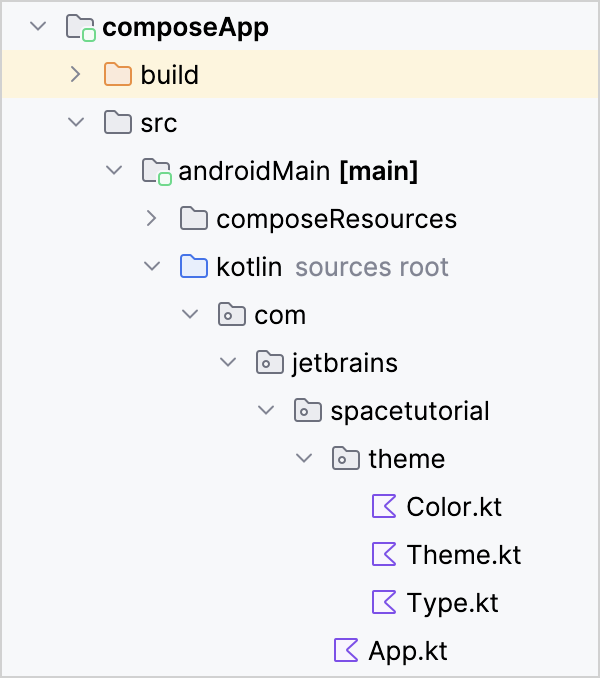
在
theme套件內的每個檔案中,更改package行以引用您建立的套件:kotlinpackage com.jetbrains.spacetutorial.theme在
Color.kt檔案中,為您將用於成功和不成功發射的顏色新增兩個變數:kotlinval app_theme_successful = Color(0xff4BB543) val app_theme_unsuccessful = Color(0xffFC100D)
實作呈現邏輯
為您的應用程式建立主要的 App() 可組合函數,並從 ComponentActivity 類別呼叫它:
開啟
com.jetbrains.spacetutorial套件中theme目錄旁邊的App.kt檔案,並替換預設的App()可組合函數:kotlinpackage com.jetbrains.spacetutorial import androidx.compose.material3.pulltorefresh.rememberPullToRefreshState import androidx.compose.runtime.Composable import androidx.compose.runtime.getValue import androidx.compose.runtime.mutableStateOf import androidx.compose.runtime.remember import androidx.compose.runtime.rememberCoroutineScope import androidx.compose.runtime.setValue import org.jetbrains.compose.ui.tooling.preview.Preview import org.koin.androidx.compose.koinViewModel import androidx.compose.material3.ExperimentalMaterial3Api @OptIn( ExperimentalMaterial3Api::class ) @Composable @Preview fun App() { val viewModel = koinViewModel<RocketLaunchViewModel>() val state by remember { viewModel.state } val coroutineScope = rememberCoroutineScope() var isRefreshing by remember { mutableStateOf(false) } val pullToRefreshState = rememberPullToRefreshState() }在這裡,您正在使用 Koin ViewModel API 來引用您在 Android Koin 模組中宣告的
viewModel。現在新增將實作載入畫面、發射結果欄和下拉重新整理動作的 UI 程式碼:
kotlinpackage com.jetbrains.spacetutorial import androidx.compose.foundation.layout.Arrangement import androidx.compose.foundation.layout.Column import androidx.compose.foundation.layout.Spacer import androidx.compose.foundation.layout.fillMaxSize import androidx.compose.foundation.layout.height import androidx.compose.foundation.layout.padding import androidx.compose.foundation.lazy.LazyColumn import androidx.compose.foundation.lazy.items import androidx.compose.material3.HorizontalDivider import androidx.compose.material3.MaterialTheme import androidx.compose.material3.Scaffold import androidx.compose.material3.Text import androidx.compose.material3.TopAppBar import androidx.compose.material3.pulltorefresh.PullToRefreshBox import androidx.compose.ui.Alignment import androidx.compose.ui.Modifier import androidx.compose.ui.unit.dp import com.jetbrains.spacetutorial.entity.RocketLaunch import com.jetbrains.spacetutorial.theme.AppTheme import com.jetbrains.spacetutorial.theme.app_theme_successful import com.jetbrains.spacetutorial.theme.app_theme_unsuccessful import kotlinx.coroutines.launch ... @OptIn( ExperimentalMaterial3Api::class ) @Composable @Preview fun App() { val viewModel = koinViewModel<RocketLaunchViewModel>() val state by remember { viewModel.state } val coroutineScope = rememberCoroutineScope() var isRefreshing by remember { mutableStateOf(false) } val pullToRefreshState = rememberPullToRefreshState() AppTheme { Scaffold( topBar = { TopAppBar( title = { Text( "SpaceX Launches", style = MaterialTheme.typography.headlineLarge ) } ) } ) { padding -> PullToRefreshBox( modifier = Modifier .fillMaxSize() .padding(padding), state = pullToRefreshState, isRefreshing = isRefreshing, onRefresh = { isRefreshing = true coroutineScope.launch { viewModel.loadLaunches() isRefreshing = false } } ) { if (state.isLoading && !isRefreshing) { Column( verticalArrangement = Arrangement.Center, horizontalAlignment = Alignment.CenterHorizontally, modifier = Modifier.fillMaxSize() ) { Text("載入中...", style = MaterialTheme.typography.bodyLarge) } } else { LazyColumn { items(state.launches) { launch: RocketLaunch -> Column(modifier = Modifier.padding(16.dp)) { Text( text = "${launch.missionName} - ${launch.launchYear}", style = MaterialTheme.typography.headlineSmall ) Spacer(Modifier.height(8.dp)) Text( text = if (launch.launchSuccess == true) "成功" else "不成功", color = if (launch.launchSuccess == true) app_theme_successful else app_theme_unsuccessful ) Spacer(Modifier.height(8.dp)) val details = launch.details if (details != null && details.isNotBlank()) { Text(details) } } HorizontalDivider() } } } } } } }最後,在
AndroidManifest.xml檔案的<activity>標籤中指定您的MainActivity類別:xml<manifest xmlns:android="http://schemas.android.com/apk/res/android"> ... <application ... <activity ... android:name="com.jetbrains.spacetutorial.MainActivity"> ... </activity> </application> </manifest>執行您的 Android 應用程式:從執行配置選單中選取 composeApp,選擇一個模擬器,然後按一下執行按鈕。 應用程式會自動執行 API 請求並顯示發射列表(背景顏色取決於您生成的 Material 主題):
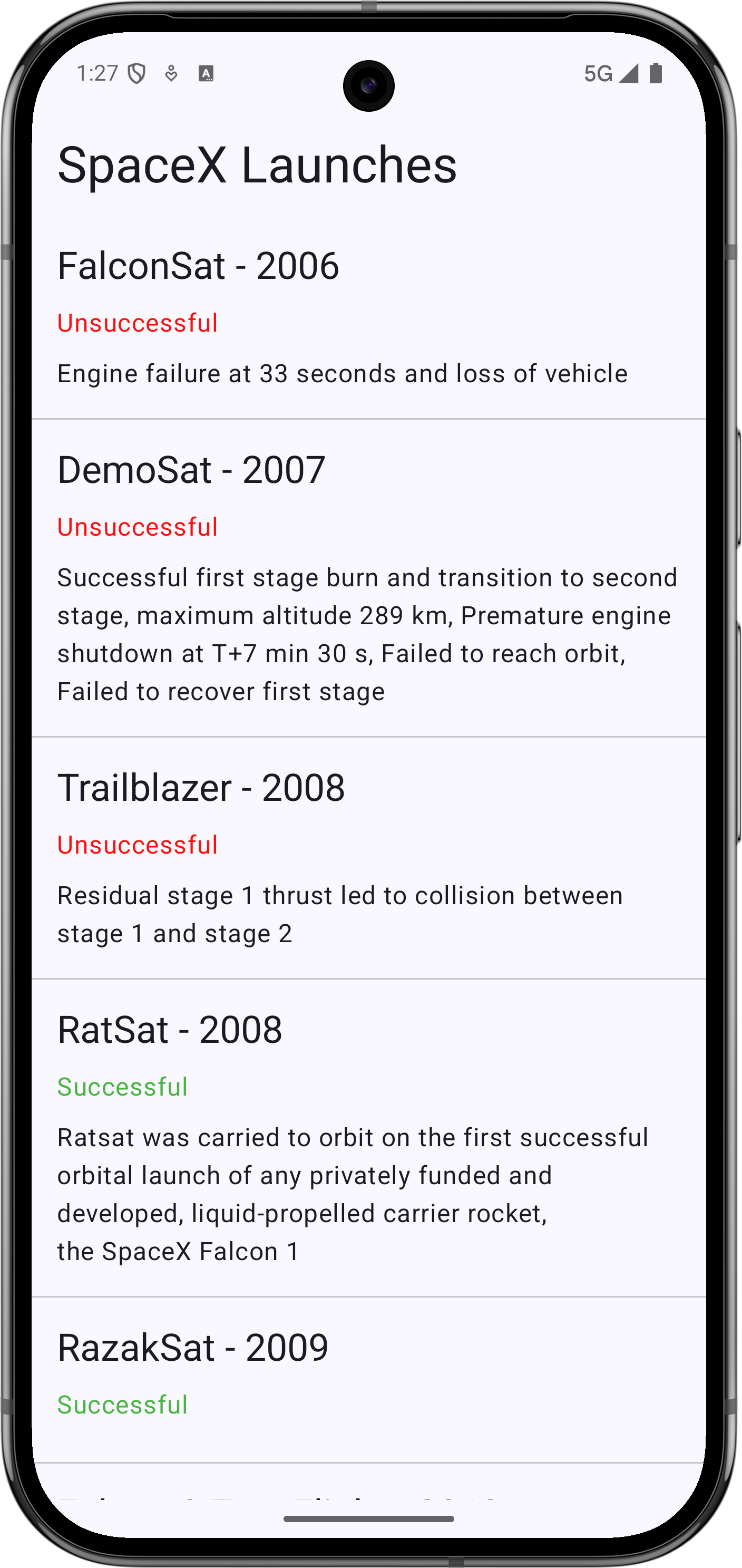
您剛剛建立了一個 Android 應用程式,其業務邏輯實作在 Kotlin 多平台模組中,其 UI 則使用原生 Jetpack Compose 建立。
建立 iOS 應用程式
對於專案的 iOS 部分,您將利用 SwiftUI 來建置使用者介面和 Model View View-Model 模式。
IntelliJ IDEA 生成的 iOS 專案已連接到共享模組。Kotlin 模組以 shared/build.gradle.kts 檔案中指定的名稱 (baseName = "Shared") 匯出,並使用常規的 import 語句匯入:import Shared。
為 SQLDelight 新增動態連結旗標
依預設,IntelliJ IDEA 生成的專案會設定為 iOS 框架的靜態連結。
要在 iOS 上使用原生 SQLDelight 驅動程式,請新增動態連結器旗標,允許 Xcode 工具找到系統提供的 SQLite 二進位檔:
- 在 IntelliJ IDEA 中,選取 File | Open Project in Xcode 選項以在 Xcode 中開啟您的專案。
- 在 Xcode 中,雙擊專案名稱以開啟其設定。
- 切換到 Build Settings 分頁並搜尋 Other Linker Flags 欄位。
- 展開該欄位,按一下 Debug 欄位旁邊的加號, 然後將
-lsqlite3字串貼到 Any Architecture | Any SDK 中。 - 對 Other Linker Flags | Release 欄位重複此過程。

為 iOS 依賴注入準備 Koin 類別
要在 Swift 程式碼中使用 Koin 類別和函數,請建立一個特殊的 KoinComponent 類別並宣告 iOS 的 Koin 模組。
在
shared/src/iosMain/kotlin/原始碼集中,建立一個名為com/jetbrains/spacetutorial/KoinHelper.kt的檔案(它將出現在cache資料夾旁邊)。新增
KoinHelper類別,它將使用惰性 Koin 注入來包裝SpaceXSDK類別:kotlinpackage com.jetbrains.spacetutorial import org.koin.core.component.KoinComponent import com.jetbrains.spacetutorial.entity.RocketLaunch import org.koin.core.component.inject class KoinHelper : KoinComponent { private val sdk: SpaceXSDK by inject<SpaceXSDK>() suspend fun getLaunches(forceReload: Boolean): List<RocketLaunch> { return sdk.getLaunches(forceReload = forceReload) } }在
KoinHelper類別之後,新增initKoin()函數,您將在 Swift 中使用它來初始化和啟動 iOS Koin 模組:kotlinimport com.jetbrains.spacetutorial.cache.IOSDatabaseDriverFactory import com.jetbrains.spacetutorial.network.SpaceXApi import org.koin.core.context.startKoin import org.koin.dsl.module fun initKoin() { startKoin { modules(module { single<SpaceXApi> { SpaceXApi() } single<SpaceXSDK> { SpaceXSDK( databaseDriverFactory = IOSDatabaseDriverFactory(), api = get() ) } }) } }
現在,您可以在 iOS 應用程式中啟動 Koin 模組,以將原生資料庫驅動程式與通用的 SpaceXSDK 類別一起使用。
實作 UI
首先,您將為顯示列表中的項目建立一個 RocketLaunchRow SwiftUI 視圖。它將基於 HStack 和 VStack 視圖。RocketLaunchRow 結構上將有擴展,其中包含用於顯示資料的實用輔助函數。
在 IntelliJ IDEA 中,請確保您處於 Project 視圖。
在
iosApp資料夾中建立一個新的 Swift 檔案,與ContentView.swift並列,並將其命名為RocketLaunchRow。使用以下程式碼更新
RocketLaunchRow.swift檔案:Swiftimport SwiftUI import Shared struct RocketLaunchRow: View { var rocketLaunch: RocketLaunch var body: some View { HStack() { VStack(alignment: .leading, spacing: 10.0) { Text("\(rocketLaunch.missionName) - \(String(rocketLaunch.launchYear))").font(.system(size: 18)).bold() Text(launchText).foregroundColor(launchColor) Text("發射年份: \(String(rocketLaunch.launchYear))") Text("\(rocketLaunch.details ?? "")") } Spacer() } } } extension RocketLaunchRow { private var launchText: String { if let isSuccess = rocketLaunch.launchSuccess { return isSuccess.boolValue ? "成功" : "不成功" } else { return "無資料" } } private var launchColor: Color { if let isSuccess = rocketLaunch.launchSuccess { return isSuccess.boolValue ? Color.green : Color.red } else { return Color.gray } } }發射列表將顯示在
ContentView視圖中,該視圖已包含在專案中。為
ContentView類別建立一個擴展,其中包含一個ViewModel類別,該類別將準備和管理資料。 將以下程式碼新增到ContentView.swift檔案中:Swiftextension ContentView { enum LoadableLaunches { case loading case result([RocketLaunch]) case error(String) } @MainActor class ViewModel: ObservableObject { @Published var launches = LoadableLaunches.loading } }視圖模型 (
ContentView.ViewModel) 透過 Combine 框架 與視圖 (ContentView) 連接:ContentView.ViewModel類別被宣告為ObservableObject。@Published屬性用於launches屬性,所以視圖模型將在每次此屬性更改時發出訊號。
移除
ContentView_Previews結構:您不需要實作應與您的視圖模型相容的預覽。更新
ContentView類別的主體以顯示發射列表並新增重新載入功能。- 這是 UI 的基礎:您將在教學的下一階段實作
loadLaunches函數。 viewModel屬性標記有@ObservedObject屬性以訂閱視圖模型。
swiftstruct ContentView: View { @ObservedObject private(set) var viewModel: ViewModel var body: some View { NavigationView { listView() .navigationBarTitle("SpaceX 發射") .navigationBarItems(trailing: Button("重新載入") { self.viewModel.loadLaunches(forceReload: true) }) } } private func listView() -> AnyView { switch viewModel.launches { case .loading: return AnyView(Text("載入中...").multilineTextAlignment(.center)) case .result(let launches): return AnyView(List(launches) { launch in RocketLaunchRow(rocketLaunch: launch) }) case .error(let description): return AnyView(Text(description).multilineTextAlignment(.center)) } } }- 這是 UI 的基礎:您將在教學的下一階段實作
RocketLaunch類別用作初始化List視圖的參數,因此它需要符合Identifiable協定。 該類別已經有一個名為id的屬性,所以您所要做的就是向ContentView.swift的底部新增一個擴展:Swiftextension RocketLaunch: Identifiable { }
載入資料
要在視圖模型中擷取有關火箭發射的資料,您將需要 Multiplatform 函式庫中的 KoinHelper 類別實例。 它將允許您使用正確的資料庫驅動程式呼叫 SDK 函數。
在
ContentView.swift檔案中,展開ViewModel類別以包含KoinHelper物件和loadLaunches函數:Swiftextension ContentView { // ... @MainActor class ViewModel: ObservableObject { // ... let helper: KoinHelper = KoinHelper() init() { self.loadLaunches(forceReload: false) } func loadLaunches(forceReload: Bool) { // 待辦: 擷取資料 } } }呼叫
KoinHelper.getLaunches()函數(它將代理呼叫到SpaceXSDK類別)並將結果儲存在launches屬性中:Swiftfunc loadLaunches(forceReload: Bool) { Task { do { self.launches = .loading let launches = try await helper.getLaunches(forceReload: forceReload) self.launches = .result(launches) } catch { self.launches = .error(error.localizedDescription) } } }當您將 Kotlin 模組編譯成 Apple 框架時,暫停函數 可以使用 Swift 的
async/await機制呼叫。由於
getLaunches函數在 Kotlin 中標記有@Throws(Exception::class)註解,因此任何屬於Exception類別或其子類別實例的異常都將作為NSError傳播到 Swift。 因此,所有此類異常都可以由loadLaunches()函數捕獲。前往應用程式的進入點
iOSApp.swift檔案,並初始化 Koin 模組、視圖和視圖模型:Swiftimport SwiftUI import Shared @main struct iOSApp: App { init() { KoinHelperKt.doInitKoin() } var body: some Scene { WindowGroup { ContentView(viewModel: .init()) } } }在 IntelliJ IDEA 中,切換到 iosApp 配置,選擇一個模擬器,然後執行它以查看結果:
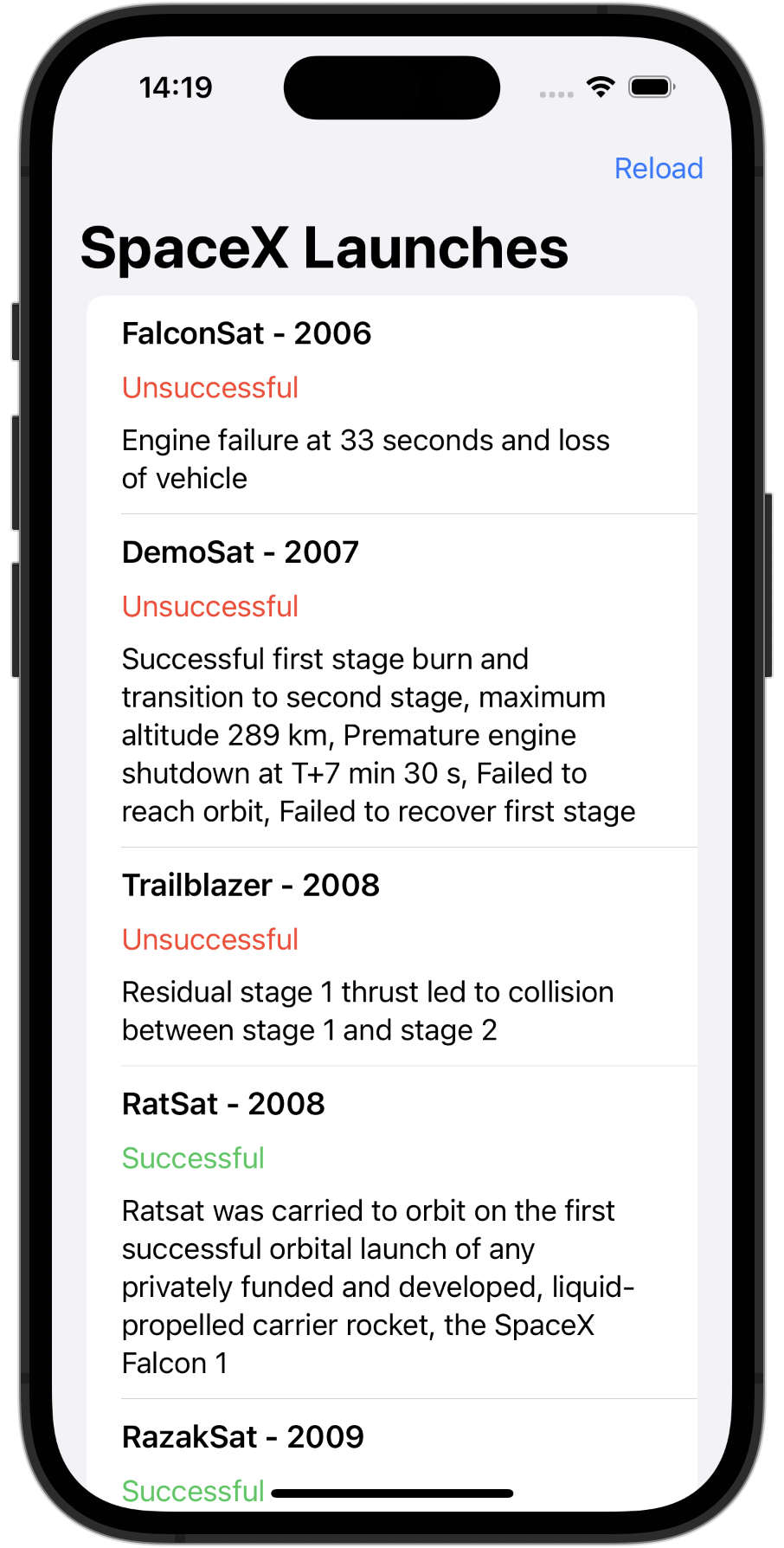
您可以在
final分支 上找到專案的最終版本。
接下來是什麼?
本教學包含一些潛在的資源密集型操作,例如在主執行緒中解析 JSON 和向資料庫發出請求。要了解如何編寫並發程式碼和優化您的應用程式,請參閱 協程指南。
您還可以查看這些額外的學習材料:
